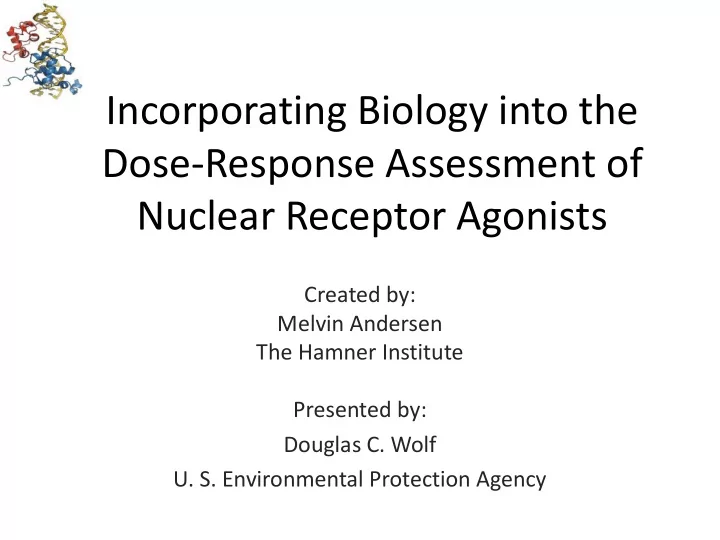

Incorporating Biology into the Dose-Response Assessment of Nuclear Receptor Agonists Created by: Melvin Andersen The Hamner Institute Presented by: Douglas C. Wolf U. S. Environmental Protection Agency
Major Goals of the Nuclear Receptors Workshop Establish a mode of action (MOA) for NR-mediated rodent liver tumors Phenobarbital for CAR/PXR; DEHP (and clofibrate) for PPAR α ; TCDD • for AHR Applied the IPCS Framework for Human Relevance and the modified Hill • Criteria applied to MOA (IPCS and EPA MOA Framework) General Charge Questions 1. Is a minimum threshold of ligand necessary for activation to stimulate downstream responses including gene expression? 2. Is a minimum threshold of receptor ligand required for any toxicological responses? 3. Is linear low ‐ dose modeling of receptor ligands appropriate, based on the underlying science of nuclear receptor signaling biology, and if not, provide insights into more appropriate low ‐ dose modeling approaches? 2
Human Relevance Framework Relevant or Unknown 1.) Is the weight of evidence sufficient to establish the mode of action? Human Not Relevance Relevant in Humans Not Sufficient Sufficient Yes 2.) Can human relevance of the MOA be reasonably excluded on the basis of fundamental qualitative differences? No 3.) Can human relevance of the MOA be reasonably excluded on the basis of fundamental quantitative differences? Are there any quantitative differences in the key events such that default values for uncertainty factors for species or individual differences could be modified? Yes No Boobis et al., 2006
Using Hill Criteria to Determine Key Events for Mouse Liver Tumor MOA • Key Event: Empirically observable causal precursor step to the adverse outcome that is a necessary element of the mode of action. Required for the MOA but may not be sufficient to induce the adverse outcome alone. • Associative Event: Biological processes that are not causal and necessary key events but are reliable indicators or markers for key events. Can be used as markers for a key event or as indicators of exposure. • Modulating Factor: Biological responses that are not necessary to induce the adverse outcome, but could modulate the dose-response behavior or probability of inducing one or more key events or the adverse outcome. 4
Quantitative Dose-Response Modeling Nuclear Ligand Binding Receptor Partner Protein(s) Molecular Co-Regulatory Proteins Interactions mRNA (RT-PCR, genomics) Transcription Protein Formation and Translation Change in CYPs Enzyme Activity ROS or Protein Function Change in Cell, Tissue, or Histopathology Organ Function Clinical Changes
Dose-Response/Temporality Concordance Table AHR Table 1: Dose Response, Temporality Concordance
Species Concordance, Human Relevance Table, AHR
Dose-Response/Temporality Concordance Table CAR/PXR
Species Concordance/Human Relevance Table CAR/PXR
Dose-Response/Temporality Concordance Table PPAR α
Species Concordance/Human Relevance Table PPAR α
Summary AHR: The AHR expert panel, for the first time in an expert panel format, rigorously applied the MOA framework and agreed on a mode of action. CAR/PXR: The CAR expert panel identified the relevant data and rigorously applied the MOA and HRF with emphasis on the qualitative and quantitative aspects of human relevance. PPAR α : The PPAR α expert panel built upon previous applications of the framework using significant new data that allowed for refinement of the key event descriptions and updated considerations related to human relevance. Each panel identified key data needs and suggested improvements for application of the MOA/HRF. A series of manuscripts will be forthcoming on the results of this workshop. 18
Recommend
More recommend